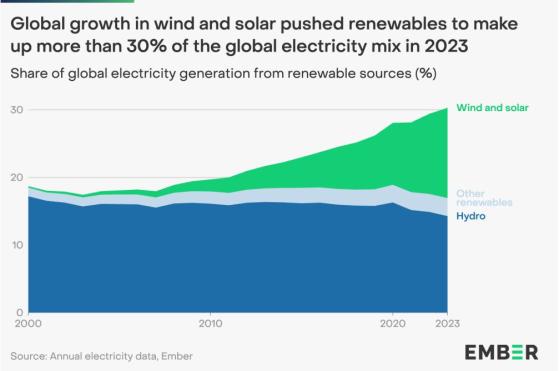The scales may finally be tipping in the global decarbonisation of energy, with 2023 marking a pivot point in the make-up of the global energy mix, according to a report by the Ember energy think tank in its 2023 Global Electricity Review.
Fossil fuel generation is beginning to decline following record construction of solar and wind in 2023, potentially marking the peak of total emissions generated.
Renewable energy generated a record-high level of 30% of global electricity in 2023, led by solar and wind, placing the world at a precipice where fossil fuel generation may not only slow but begin to decline altogether.
Solar main driver of renewables
Solar power was the leading driver of renewable energy growth last year, notching its 19th straight year as the fastest-growing source of electricity and once again surpassing wind to become the largest source of new electricity for the second year in a row.
This year likely also would have marked the first real drop in global emissions, but major droughts in multiple regions dropped hydropower generation to a five-year low.
Under normal circumstances with hydro at full capacity, emissions would have dropped 1.1% in 2023 but the energy shortfall was met by increased coal-powered generation, instead driving emissions up 1%.
Just four countries severely affected by drought accounted for 95% of the rise in coal generation, with China, India, Vietnam and Mexico being the main drivers.
Growth outpaces demand
One of the most important revelations from the report was that increases in renewable power generation are on track to outstrip global growth in energy demand for the first time.
Growth in wind and solar generation accounted for 82% of the global economy’s rise in energy demand in 2023.
The growth in fossil fuel-powered generation has also slowed substantially, falling from 3.5% over the 10 years to 2013 to just 1.3% from 2014 to 2023 – fossil fuel generation would’ve been about 22% higher over this period had renewables not entered the energy mix.
Ember has also forecast an overall drop in fossil fuel generation for 2024, with higher declines in subsequent years.
The think tank predicts a demand growth of 968 Terrawatt-hours (TWh) in 2024 but expects an even greater rise of more than 1,300 TWh of renewable energy capacity, meaning an overall drop of 333 TWh or a 2% fall in fossil fuel generation.
The report asserts that about half of the world’s economies are already at least five years past their peak emissions period – OECD countries are unsurprisingly leading this charge, with collective power sector emissions peaking in 2007 and falling 28% in the years following.
Fall in emissions “inevitable”
As a result, the IEA’s pathway to net zero has flattened considerably, becoming much more achievable by 2030 compared to earlier estimates.
“The rise in solar capacity that happened during 2023 really unlocks the possibility that we are able to reach that level of renewables by 2030, and the tripling of capacity that was promised at COP28,” Dave Jones, Ember’s director of global insights said in an interview.
While industry and energy experts point to ongoing barriers in grid connections and permitting for new renewable energy projects, Ember expects fossil fuel power generation to fall to less than 60% of global energy production in 2024, the first time since 2000 (when the think tank’s data begins).
“The decade ahead will see the energy transition enter a new phase,” the report states. “A permanent decline in fossil fuel use in the power sector at a global level is now inevitable.”
Read more on Proactive Investors AU
